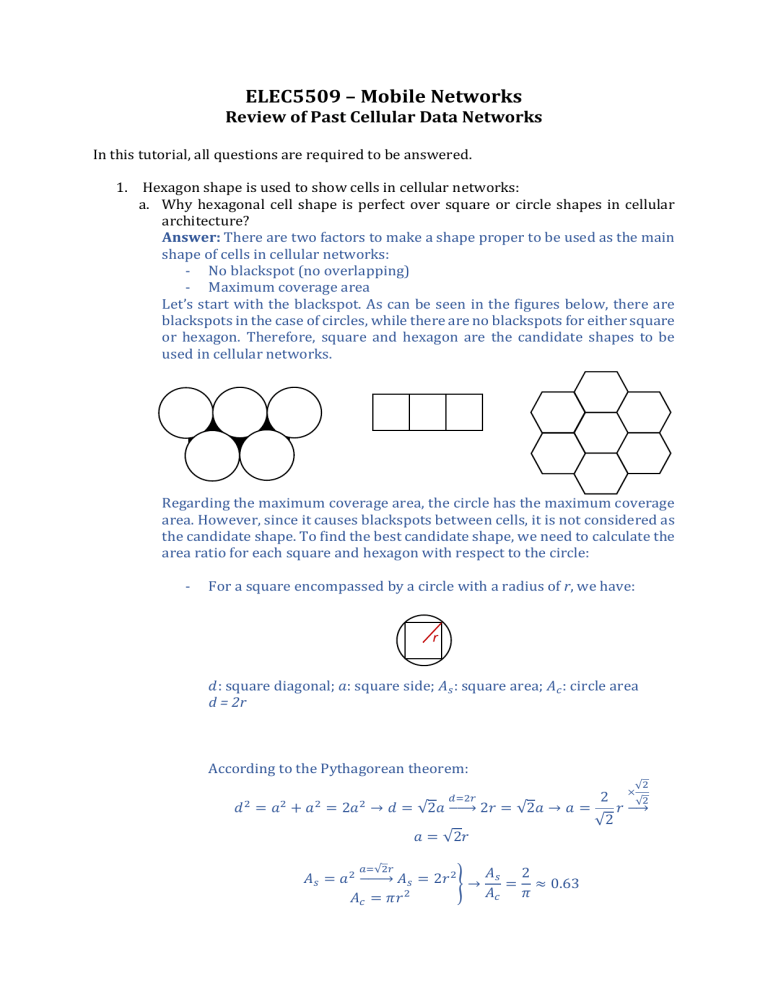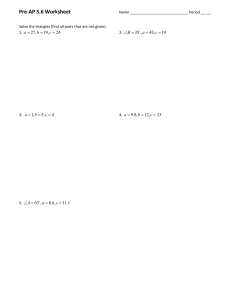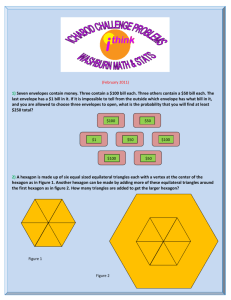Mobile Networks Tutorial: Cell Shapes, Frequency Reuse, Capacity
advertisement

ELEC5509 – Mobile Networks Review of Past Cellular Data Networks In this tutorial, all questions are required to be answered. 1. Hexagon shape is used to show cells in cellular networks: a. Why hexagonal cell shape is perfect over square or circle shapes in cellular architecture? Answer: There are two factors to make a shape proper to be used as the main shape of cells in cellular networks: - No blackspot (no overlapping) - Maximum coverage area Let’s start with the blackspot. As can be seen in the figures below, there are blackspots in the case of circles, while there are no blackspots for either square or hexagon. Therefore, square and hexagon are the candidate shapes to be used in cellular networks. Regarding the maximum coverage area, the circle has the maximum coverage area. However, since it causes blackspots between cells, it is not considered as the candidate shape. To find the best candidate shape, we need to calculate the area ratio for each square and hexagon with respect to the circle: - For a square encompassed by a circle with a radius of r, we have: r 𝑑𝑑: square diagonal; 𝑎𝑎: square side; 𝐴𝐴𝑠𝑠 : square area; 𝐴𝐴𝑐𝑐 : circle area d = 2r According to the Pythagorean theorem: 𝑑𝑑=2𝑟𝑟 𝑑𝑑 2 = 𝑎𝑎2 + 𝑎𝑎2 = 2𝑎𝑎2 → 𝑑𝑑 = √2𝑎𝑎 �⎯⎯� 2𝑟𝑟 = √2𝑎𝑎 → 𝑎𝑎 = 𝑎𝑎 = √2𝑟𝑟 𝑎𝑎=√2𝑟𝑟 𝐴𝐴𝑠𝑠 = 𝑎𝑎2 �⎯⎯⎯� 𝐴𝐴𝑠𝑠 = 2𝑟𝑟 2 � → 𝐴𝐴𝑠𝑠 = 2 ≈ 0.63 𝐴𝐴𝑐𝑐 𝜋𝜋 𝐴𝐴𝑐𝑐 = 𝜋𝜋𝑟𝑟 2 2 √2 × √2 √2 𝑟𝑟 �⎯� - For a hexagon encompassed by a circle with a radius of r, we have: r 𝑎𝑎: hexagon side; 𝐴𝐴ℎ : hexagon area 𝑎𝑎 = 𝑟𝑟 3√3 2 𝑎𝑎=𝑟𝑟 3√3 2 𝐴𝐴ℎ = 𝑎𝑎 �⎯� 𝐴𝐴ℎ = 𝑟𝑟 � → 𝐴𝐴𝑠𝑠 = 3√3 ≈ 0.83 2 2 𝐴𝐴𝑐𝑐 2𝜋𝜋 𝐴𝐴𝑐𝑐 = 𝜋𝜋𝑟𝑟 2 It can be found that the hexagon provides more coverage area than the square. Therefore, hexagon is the best candidate for the cells’ shape in the cellular networks. b. How is the radius calculated for a hexagonal-shaped cell? Answer: The distance of an edge from the centers is defined as the radius of the hexagon. 2. One of methods to improve the network throughput is frequency reuse: a. Define Frequency reuse. Answer: Frequency reuse is the process of the same radio frequencies on radio transmitter sites within a geographic area that are separated by sufficient distance to cause minimal interference with each other. Frequency reuse allows for a dramatic increase in the number of customers that can be served (capacity) within a geographic area on a limited amount of spectrum (limited number of radio channels). Figure 1: Systems with frequency reuse factor of 1/3, 1/4, and 1/7 Figure 1 shows the system with different frequency reuse factors. As can be seen in the figure, a set of nodes with the same color make a cluster. Moreover, cells with the same numbers use the same frequency band. b. What is co-channel distance D? On what factors does D depend? Answer: Co-channel distance 𝐷𝐷 is the minimum distance between centers of cells that use the same frequency band. 1 1 Figure 2: Co-channel distance D As seen in Figure 2, both cells numbered as 1 use the same frequency. 𝑅𝑅 shows the radius of the cell and 𝐷𝐷 is the co-channel distance. For 𝐷𝐷 we have: 𝐷𝐷 = √3𝑁𝑁𝑅𝑅, where 𝑁𝑁 is the number of cells in a cluster and is calculated as: 𝑁𝑁 = 𝑖𝑖 2 + 𝑖𝑖𝑖𝑖 + 𝑗𝑗 2 , where 𝑖𝑖 and 𝑗𝑗 are integers, 𝑖𝑖 ≥ 0, 𝑗𝑗 ≥ 𝑖𝑖. To reach the next co-channel cell, you must: - Move perpendicular to any of the 6 surfaces of the original cell and passing over 𝑖𝑖 cells; then rotating 60° counterclockwise and moving along 𝑗𝑗 cells to reach all adjacent co-channel cells. - Or move perpendicular to one of the surfaces of the original cell and passing over 𝑗𝑗 cells then rotating 60° clockwise and moving along 𝑖𝑖 cells to reach all adjacent co‐channel cells. c. How is the signal-to-interference ratio (S/I) relating with co-channel reuse ratio (q)? Answer: Co-channel reuse ratio is defined as 𝑞𝑞 = 𝐷𝐷 𝑅𝑅 Signal to interference ratio for the frequency reuse is defined as: 𝑆𝑆 𝑅𝑅 −𝑁𝑁 = , 𝐼𝐼 ∑𝑖𝑖0 𝐷𝐷−𝑁𝑁 𝑖𝑖=1 where 𝑖𝑖0 is the number of interfere nodes. Since a hexagon has 6 sides, then there would be 6 interfere nodes for each cell. Therefore, 𝑖𝑖0 = 6. By substituting 𝑖𝑖0 in the above-mentioned equation, we have 𝑅𝑅 −𝑁𝑁 𝑆𝑆 𝐷𝐷 𝑁𝑁 𝑆𝑆 𝐷𝐷 𝑆𝑆 1/𝑁𝑁 𝑆𝑆 1 𝑅𝑅 −𝑁𝑁 = � � → � � = 6 → � � = 6 → = �6 � → 𝐷𝐷 𝐼𝐼 𝑅𝑅 𝐼𝐼 𝑅𝑅 𝐼𝐼 𝐼𝐼 6 𝐷𝐷 𝑆𝑆 1/𝑁𝑁 𝑞𝑞 = �6 � , 𝐼𝐼 where 1/𝑁𝑁 is the frequency reuse factor. 3. Define cell splitting and explain its main objective. Answer: Cell splitting is the process of subdividing a congested cell into smaller cells. Each cell will have its own BS and a corresponding reduction in antenna length which leads to an increase in capacity. Meanwhile, it requires more frequent handoff, difficult channel assignment, and sometimes needs special care as calls are not split simultaneously. Figure 3: Cell splitting 4. Define cell sectoring and explain its main objective. Answer: Cell sectoring involves replacing the Omni-directional antenna at each BS by six, four, or three sector antennas of 60, 90, or 120 degrees opening to increase subscriber capacity in cellular networks, overcome channel interference, and improve the S/I ratio. Figure 4: Cell sectoring 5. Consider a cell with a radius of 2km in a mobile communication system with a bandwidth (𝐵𝐵) of 10MHz. The cell includes 10 nodes, which are uniformly distributed in the cell's area. All nodes have the same transmission power (𝑃𝑃𝑡𝑡 ) that is equal to 23dBm. It is assumed that the orthogonal frequency division multiplexing (OFDM) method has been used to assign the frequencies to the nodes. Therefore, there is no interference between the nodes. Let’s the noise power (𝜎𝜎 2 ), the channel gain (𝑔𝑔), and the path loss exponent (𝛼𝛼) be equal to -109dBm, -40dB, and 3, respectively. If the distance between node 5 and the BS (𝑑𝑑) is 0.5km, what is the channel capacity between node 5 and the BS? Answer: 𝐵𝐵 = 107 𝐻𝐻𝐻𝐻; 𝑃𝑃𝑡𝑡 = 0.2𝑊𝑊𝑊𝑊𝑊𝑊𝑊𝑊; 𝑔𝑔 = 1𝑒𝑒 − 4; 𝑑𝑑 = 500𝑚𝑚; 𝛼𝛼 = 3; 𝜎𝜎 2 = 1.26𝑒𝑒 − 14𝑊𝑊𝑊𝑊𝑊𝑊𝑊𝑊 0.2 × 1𝑒𝑒 − 4 × (500)−3 𝑃𝑃𝑡𝑡 𝑔𝑔𝑔𝑔 −𝛼𝛼 7 � = 10 log 2 �1 + � = 11.37𝑀𝑀𝑀𝑀𝑀𝑀𝑀𝑀 𝐶𝐶 = 𝐵𝐵 log 2 �1 + 𝜎𝜎 2 1.26𝑒𝑒 − 14


